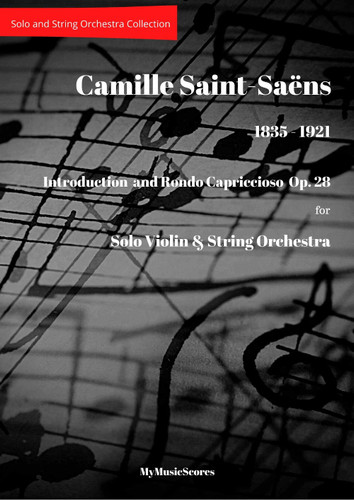Saint-Saëns Havanaise for Solo Violin and String Orchestra
Saint-Saëns: Havanaise Op. 83 for Solo Violin and String Orchestra
Experience the captivating charm and dazzling brilliance of Camille Saint-Saëns's iconic Havanaise, Op. 83, now masterfully arranged for solo violin and string orchestra. This celebrated work, a beloved staple of the violin repertoire infused with Spanish-Cuban flair, is reimagined to capture all its vibrant allure and intricate melodies within the rich, expressive sonorities of a string ensemble.
Camille Saint-Saëns (1835-1921), one of France's most versatile and influential composers, crafted his "Havanaise" as a sensuous and virtuosic showpiece, originally for violin and full orchestra (or violin and piano). Its flowing melodies, rhythmic sophistication, and technical demands make it a perennial favourite. This arrangement by Paul Wood meticulously adapts the original full orchestral accompaniment to a dedicated string orchestra, enriching the harmonic textures and providing a dynamic, sympathetic backdrop that enhances the solo violin's commanding presence. It offers a practical yet uncompromising option for advanced soloists and ensembles who may not have access to a full symphony orchestra, allowing this magnificent work to be performed more widely without sacrificing its artistic impact.
Key Features:
- Instrumentation: Violin Solo & String Orchestra (Violin I, Violin II, Viola, Cello, Contrabass)
- Original Instrumentation: Violin & Full Orchestra (or Piano)
- Difficulty: Advanced Violin Solo, Advanced String Orchestra
- Arranger: Paul Wood
- Fidelity: This arrangement remains true to Saint-Saëns's original solo line and musical intent, carefully adapted to showcase the violin with a sympathetic string orchestra accompaniment.
- Contents: PDF File of full Score and all individual instrumental parts provided.
Saint-Saëns's Havanaise Op. 83 is renowned for its captivating melodies, its alluring rhythms, and its dazzling display of violinistic artistry. This arrangement brings those qualities to the forefront, offering a truly rewarding experience for the advanced violin soloist and providing a monumental, engaging piece for advanced string orchestras.
Elevate your repertoire with this exciting and beautifully orchestrated version of a Romantic classic.
Perfect for: Concert programmes, advanced student recitals, and orchestras seeking an elegant, expressive, and technically demanding showpiece with string-only accompaniment.
Would you like a printed edition of this score?
We've partnered up with JWPepper. They will print and ship your score for you.
Click here to get a printed edition of this score.
Write a Review

Saint-Saëns Havanaise for Solo Violin and String Orchestra









